Fluorescently Labeled Cellulose Nanofibers for Environmental Health and Safety Studies
Abstract
1. Introduction
2. Materials and Methods
3. Results and Discussion
3.1. Fluorescently Labeled Cellulose
3.2. Toxicity Studies
4. Conclusions
Supplementary Materials
Author Contributions
Funding
Data Availability Statement
Acknowledgments
Conflicts of Interest
References
- Moon, R.J.; Schueneman, G.T.; Simonsen, J. Overview of Cellulose Nanomaterials, Their Capabilities and Applications. Jom 2016, 68, 2383–2394. [Google Scholar] [CrossRef]
- Bohlmann, G.M. Biodegradable packaging life-cycle assessment. Environ. Prog. 2004, 23, 342–346. [Google Scholar] [CrossRef]
- Zhang, Y. Cellulose Nanofibrils. J. Renew. Mater. 2013, 1, 195–211. [Google Scholar] [CrossRef]
- Moon, R.J.; Martini, A.; Nairn, J.; Simonsen, J.; Youngblood, J. Cellulose nanomaterials review: Structure, properties and nanocomposites. Chem. Soc. Rev. 2011, 40, 3941–3994. [Google Scholar] [CrossRef] [PubMed]
- Lavoine, N.; Desloges, I.; Dufresne, A.; Bras, J. Microfibrillated cellulose—Its barrier properties and applications in cellulosic materials: A review. Carbohydr. Polym. 2012, 90, 735–764. [Google Scholar] [CrossRef]
- Hubbe, M.A.; Rojas, O.J.; Lucia, L.A. Green Modification of Surface Characteristics of Cellulosic Materials at the Molecular or Nano Scale: A Review. BioResources 2015, 10. [Google Scholar] [CrossRef]
- Nechyporchuk, O.; Belgacem, M.N.; Bras, J. Production of cellulose nanofibrils: A review of recent advances. Ind. Crop. Prod. 2016, 93, 2–25. [Google Scholar] [CrossRef]
- DeLoid, G.M.; Cao, X.Q.; Molina, R.M.; Silva, D.I.; Bhattacharya, K.; Ng, K.W.; Loo, S.C.J.; Brain, J.D.; Demokritou, P. Toxicological effects of ingested nanocellulose in in vitro intestinal epithelium and in vivo rat models. Environ. Sci.-Nano 2019, 6, 2105–2115. [Google Scholar] [CrossRef] [PubMed]
- Pradhan, S.H.; Mulenos, M.R.; Steele, L.R.; Gibb, M.; Ede, J.D.; Ong, K.J.; Shatkin, J.A.; Sayes, C.M. Physical, chemical, and toxicological characterization of fibrillated forms of cellulose using an in vitro gastrointestinal digestion and co-culture model. Toxicol. Res. 2020, 9, 290–301. [Google Scholar] [CrossRef] [PubMed]
- Khare, S.; DeLoid, G.M.; Molina, R.M.; Gokulan, K.; Couvillion, S.P.; Bloodsworth, K.J.; Eder, E.K.; Wong, A.R.; Hoyt, D.W.; Bramer, L.M.; et al. Effects of ingested nanocellulose on intestinal microbiota and homeostasis in Wistar Han rats. NanoImpact 2020, 18, 100216. [Google Scholar] [CrossRef]
- Ong, K.J.; Ede, J.D.; Pomeroy-Carter, C.A.; Sayes, C.M.; Mulenos, M.R.; Shatkin, J.A. A 90-day dietary study with fibrillated cellulose in Sprague-Dawley rats. Toxicol. Rep. 2020, 7, 174–182. [Google Scholar] [CrossRef] [PubMed]
- DeLoid, G.M.; Sohal, I.S.; Lorente, L.R.; Molina, R.M.; Pyrgiotakis, G.; Stevanovic, A.; Zhang, R.; McClements, D.J.; Geitner, N.K.; Bousfield, D.W.; et al. Reducing Intestinal Digestion and Absorption of Fat Using a Nature-Derived Biopolymer: Interference of Triglyceride Hydrolysis by Nanocellulose. ACS Nano 2018, 12, 6469–6479. [Google Scholar] [CrossRef]
- FDA. Redbook 2000: Guidance for Industry and other Stakeholders. Toxicological Principles for the Safety Assessment of Food Ingredients; U.S. Department of Health and Human Services, Food and Drug Administration: Silver Spring, MD, USA, 2007.
- Lavin, S.R.; McWhorter, T.J.; Karasov, W.H. Mechanistic bases for differences in passive absorption. J. Exp. Biol. 2007, 210, 2754–2764. [Google Scholar] [CrossRef] [PubMed]
- Lopaschuk, G.D.; Barr, R.L. Measurements of fatty acid and carbohydrate metabolism in the isolated working rat heart. In Novel Methods in Molecular and Cellular Biochemistry of Muscle; Pierce, G.N., Claycomb, W.C., Eds.; Springer: Boston, MA, USA, 1997; pp. 137–147. [Google Scholar] [CrossRef]
- Robin, M.P.; O’Reilly, R.K. Strategies for preparing fluorescently labelled polymer nanoparticles. Polym. Int. 2015, 64, 174–182. [Google Scholar] [CrossRef]
- Jiang, Z.; He, H.; Liu, H.; Thayumanavan, S. Cellular Uptake Evaluation of Amphiphilic Polymer Assemblies: Importance of Interplay between Pharmacological and Genetic Approaches. Biomacromolecules 2019, 20, 4407–4418. [Google Scholar] [CrossRef]
- Dong, S.; Roman, M. Fluorescently Labeled Cellulose Nanocrystals for Bioimaging Applications. J. Am. Chem. Soc. 2007, 129, 13810–13811. [Google Scholar] [CrossRef]
- Abitbol, T.; Palermo, A.; Moran-Mirabal, J.M.; Cranston, E.D. Fluorescent Labeling and Characterization of Cellulose Nanocrystals with Varying Charge Contents. Biomacromolecules 2013, 14, 3278–3284. [Google Scholar] [CrossRef]
- Navarro, J.R.G.; Conzatti, G.; Yu, Y.; Fall, A.B.; Mathew, R.; Edén, M.; Bergström, L. Multicolor Fluorescent Labeling of Cellulose Nanofibrils by Click Chemistry. Biomacromolecules 2015, 16, 1293–1300. [Google Scholar] [CrossRef]
- Salari, M.; Bitounis, D.; Bhattacharya, K.; Pyrgiotakis, G.; Zhang, Z.; Purington, E.; Gramlich, W.; Grondin, Y.; Rogers, R.; Bousfield, D.; et al. Development & characterization of fluorescently tagged nanocellulose for nanotoxicological studies. Environ. Sci. Nano 2019, 6, 1516–1526. [Google Scholar] [CrossRef]
- Woodcock, J.; Fox, D.M.; Gilman, J.W. Physiologically Stable Fluorophore for Digestion Toxicology Studies. U.S. Patent 17/117,424, 12 April 2020. [Google Scholar]
- NREL. Determination of Structural Carbohydrates and Lignin in Biomass: Laboratory Analytical Procedure; NREL/TP-510-42618; National Renewable Energy Laboratory: Golden, CO, USA, 2012.
- TAPPI. Acid-Insoluble Lignin in Wood and Pulp; TAPPI T222 om-06; Technical Association of the Pulp and Paper Industry: Peach Tree, GA, USA, 2006. [Google Scholar]
- TAPPI. Acid-Soluble Lignin in Wood and Pulp; TAPPI UM250; Technical Association of the Pulp and Paper Industry: Peach Tree, GA, USA, 2000. [Google Scholar]
- Beams, R.; Woodcock, J.W.; Gilman, J.W.; Stranick, S.J. Phase Mask-Based Multimodal Superresolution Microscopy. Photonics 2017, 4, 39. [Google Scholar] [CrossRef]
- Burnett, D.J.; Khoo, J.; Naderi, M.; Heng, J.Y.Y.; Wang, G.D.; Thielmann, F. Effect of Processing Route on the Surface Properties of Amorphous Indomethacin Measured by Inverse Gas Chromatography. AAPS PharmSciTech 2012, 13, 1511–1517. [Google Scholar] [CrossRef]
- Dorris, G.M.; Gray, D.G. Adsorption of n-alkanes at zero surface coverage on cellulose paper and wood fibers. J. Colloid Interface Sci. 1980, 77, 353–362. [Google Scholar] [CrossRef]
- Donnet, J.; Park, S.-J.; Balard, H. Evaluation of Specific Interactions of Solid Surfaces by Inverse Gas Chromatography. Chromatographia 1991, 31, 434–440. [Google Scholar] [CrossRef]
- World Health Organization. The International Pharmacopoeia, 4th ed.; Including first supplement; World Health Organization, Dept. of Essential Medicines and Pharmaceutical Policies: Geneva, Switzerland, 2012. [Google Scholar]
- Guo, Z.; Cao, X.; DeLoid, G.M.; Sampathkumar, K.; Ng, K.W.; Loo, S.C.J.; Demokritou, P. Physicochemical and Morphological Transformations of Chitosan Nanoparticles across the Gastrointestinal Tract and Cellular Toxicity in an In Vitro Model of the Small Intestinal Epithelium. J. Agric. Food Chem. 2020, 68, 358–368. [Google Scholar] [CrossRef] [PubMed]
- Ström, G.; Öhgren, C.; Ankerfors, M. Nanocellulose as an additive in foodstuff. Innventia Rep. 2013, 403, 1–25. [Google Scholar]
- Truong, L.; Harper, S.L.; Tanguay, R.L. Evaluation of embryotoxicity using the zebrafish model. Methods Mol. Biol. 2011, 691, 271–279. [Google Scholar] [CrossRef] [PubMed]
- Usenko, C.Y.; Harper, S.L.; Tanguay, R.L. Fullerene C60 exposure elicits an oxidative stress response in embryonic zebrafish. Toxicol. Appl. Pharmacol. 2008, 229, 44–55. [Google Scholar] [CrossRef] [PubMed]
- Ulrich, G.; Ziessel, R.; Harriman, A. The Chemistry of Fluorescent Bodipy Dyes: Versatility Unsurpassed. Angew. Chem. Int. Ed. 2008, 47, 1184–1201. [Google Scholar] [CrossRef] [PubMed]
- Sola-Llano, R.; Bañuelos, J. Introductory Chapter: BODIPY Dye, an All-in-One Molecular Scaffold for (Bio)Photonics. In BODIPY Dyes—A Privilege Molecular Scaffold with Tunable Properties; Bañuelos-Prieto, J., Llano, R.S., Eds.; IntechOpen: London, UK, 2018. [Google Scholar] [CrossRef]
- Gonçalves, M.S.T. Fluorescent Labeling of Biomolecules with Organic Probes. Chem. Rev. 2009, 109, 190–212. [Google Scholar] [CrossRef]
- Marfin, Y.S.; Solomonov, A.V.; Timin, A.S.; Rumyantsev, E.V. Recent Advances of Individual BODIPY and BODIPY-Based Functional Materials in Medical Diagnostics and Treatment. Curr. Med. Chem. 2017, 24, 2745–2772. [Google Scholar] [CrossRef]
- Kolemen, S.; Akkaya, E.U. Reaction-based BODIPY probes for selective bio-imaging. Coord. Chem. Rev. 2018, 354, 121–134. [Google Scholar] [CrossRef]
- Vodyanova, O.S.; Kochergin, B.A.; Usoltsev, S.D.; Marfin, Y.S.; Rumyantsev, E.V.; Aleksakhina, E.L.; Tomilova, I.K. BODIPY dyes in bio environment: Spectral characteristics and possibilities for practical application. J. Photochem. Photobiol. A Chem. 2018, 350, 44–51. [Google Scholar] [CrossRef]
- Kaur, P.; Singh, K. Recent advances in the application of BODIPY in bioimaging and chemosensing. J. Mater. Chem. C 2019, 7, 11361–11405. [Google Scholar] [CrossRef]
- Sasmal, S.; Mohanty, K. Pretreatment of Lignocellulosic Biomass Toward Biofuel Production. In Biorefining of Biomass to Biofuels: Opportunities and Perception; Kumar, S., Sani, R.K., Eds.; Springer International Publishing: Cham, Switzerland, 2018; pp. 203–221. [Google Scholar] [CrossRef]
- Kim, S.; Holtzapple, M.T. Delignification kinetics of corn stover in lime pretreatment. Bioresour. Technol. 2006, 97, 778–785. [Google Scholar] [CrossRef] [PubMed]
- Berezin, M.Y.; Achilefu, S. Fluorescence Lifetime Measurements and Biological Imaging. Chem. Rev. 2010, 110, 2641–2684. [Google Scholar] [CrossRef] [PubMed]
- Roberts, M.S.; Dancik, Y.; Prow, T.W.; Thorling, C.A.; Lin, L.L.; Grice, J.E.; Robertson, T.A.; König, K.; Becker, W. Non-invasive imaging of skin physiology and percutaneous penetration using fluorescence spectral and lifetime imaging with multiphoton and confocal microscopy. Eur. J. Pharm. Biopharm. 2011, 77, 469–488. [Google Scholar] [CrossRef] [PubMed]
- Du, L.; Wang, Z.; Li, S.; Song, W.; Lin, W. A Comparison of Monomeric Phenols Produced from Lignin by Fast Pyrolysis and Hydrothermal Conversions. Int. J. Chem. React. Eng. 2013, 11, 135–145. [Google Scholar] [CrossRef]
- Woodcock, J.W.; Stranick, S.J.; Patel, I.; Fox, D.M.; Gilman, J.W. A new fluorescent label for use in carbohydrate nanomaterial in vivo studies. in preparation.
- Al-Shamary, E.; Khalaf, A. Influence of Fermentation Condition and Alkali Treatment on the Porosity and Thickness of Bacterial Cellulose Membranes. TOJSAT 2013, 3, 194–203. [Google Scholar]
- Budtova, T.; Navard, P. Cellulose in NaOH–water based solvents: A review. Cellulose 2016, 23, 5–55. [Google Scholar] [CrossRef]
- Siddiqui, N.; Mills, R.H.; Gardner, D.J.; Bousfield, D. Production and Characterization of Cellulose Nanofibers from Wood Pulp. J. Adhes. Sci. Technol. 2011, 25, 709–721. [Google Scholar] [CrossRef]
- Sacui, I.A.; Nieuwendaal, R.C.; Burnett, D.J.; Stranick, S.J.; Jorfi, M.; Weder, C.; Foster, E.J.; Olsson, R.T.; Gilman, J.W. Comparison of the Properties of Cellulose Nanocrystals and Cellulose Nanofibrils Isolated from Bacteria, Tunicate, and Wood Processed Using Acid, Enzymatic, Mechanical, and Oxidative Methods. ACS Appl. Mater. Interfaces 2014, 6, 6127–6138. [Google Scholar] [CrossRef]
- Nishiyama, Y.; Kuga, S.; Okano, T. Mechanism of mercerization revealed by X-ray diffraction. J. Wood Sci. 2000, 46, 452–457. [Google Scholar] [CrossRef]
- Duchemin, B.J.C. Mercerisation of cellulose in aqueous NaOH at low concentrations. Green Chem. 2015, 17, 3941–3947. [Google Scholar] [CrossRef]
- Harper, B.J.; Clendaniel, A.; Sinche, F.; Way, D.; Hughes, M.; Schardt, J.; Simonsen, J.; Stefaniak, A.B.; Harper, S.L. Impacts of chemical modification on the toxicity of diverse nanocellulose materials to developing zebrafish. Cellulose 2016, 23, 1763–1775. [Google Scholar] [CrossRef] [PubMed]
- Bitounis, D.; Pyrgiotakis, G.; Bousfield, D.; Demokritou, P. Dispersion preparation, characterization, and dosimetric analysis of cellulose nano-fibrils and nano-crystals: Implications for cellular toxicological studies. NanoImpact 2019, 15, 100171. [Google Scholar] [CrossRef]
- Lopes, V.R.; Strømme, M.; Ferraz, N. In Vitro Biological Impact of Nanocellulose Fibers on Human Gut Bacteria and Gastrointestinal Cells. Nanomaterials 2020, 10, 1159. [Google Scholar] [CrossRef] [PubMed]
- van Pomeren, M.; Brun, N.R.; Peijnenburg, W.J.G.M.; Vijver, M.G. Exploring uptake and biodistribution of polystyrene (nano)particles in zebrafish embryos at different developmental stages. Aquat. Toxicol. 2017, 190, 40–45. [Google Scholar] [CrossRef] [PubMed]
- Nix, C.E.; Harper, B.J.; Conner, C.G.; Richter, A.P.; Velev, O.D.; Harper, S.L. Toxicological Assessment of a Lignin Core Nanoparticle Doped with Silver as an Alternative to Conventional Silver Core Nanoparticles. Antibiotics 2018, 7, 40. [Google Scholar] [CrossRef] [PubMed]
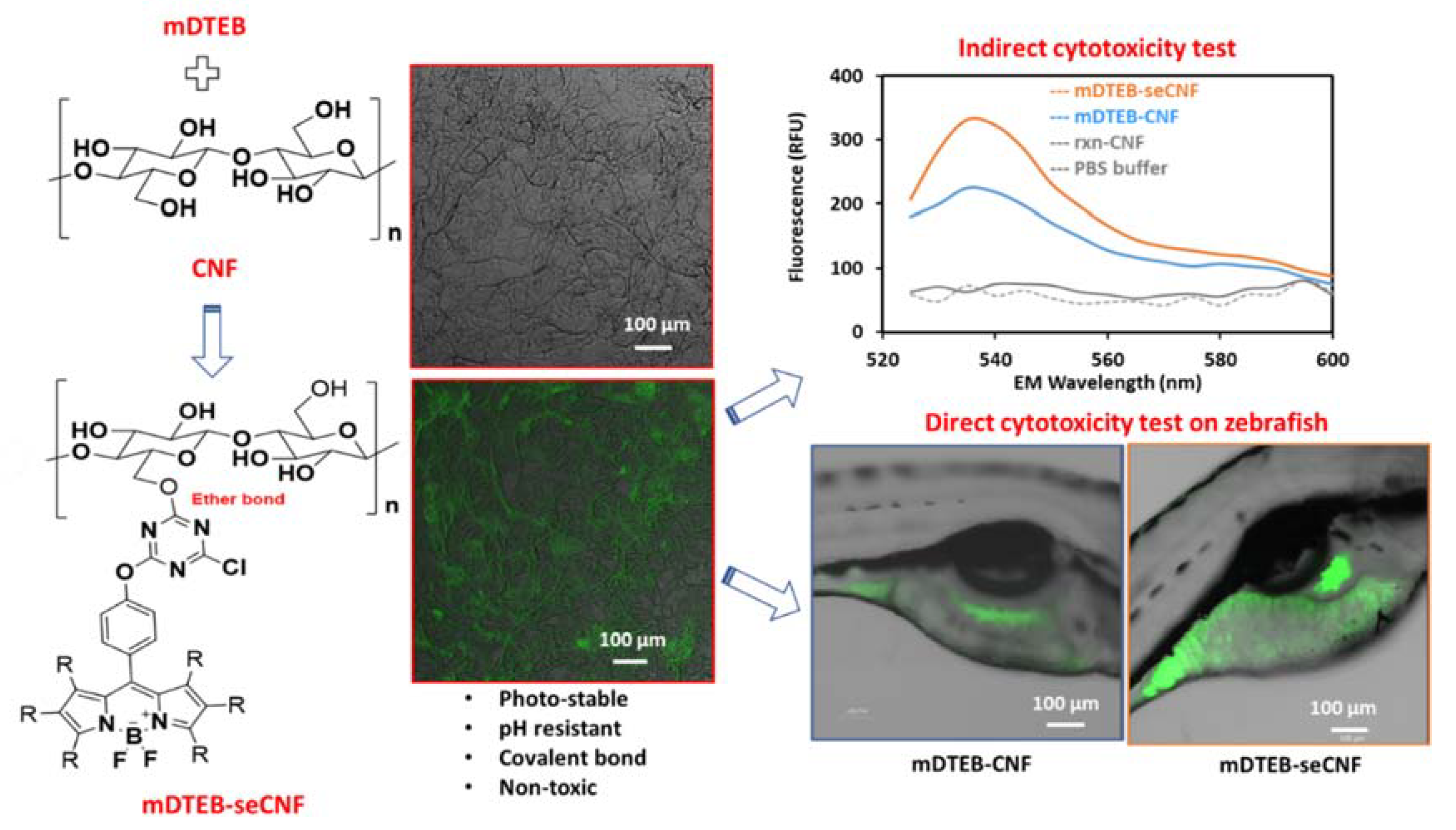

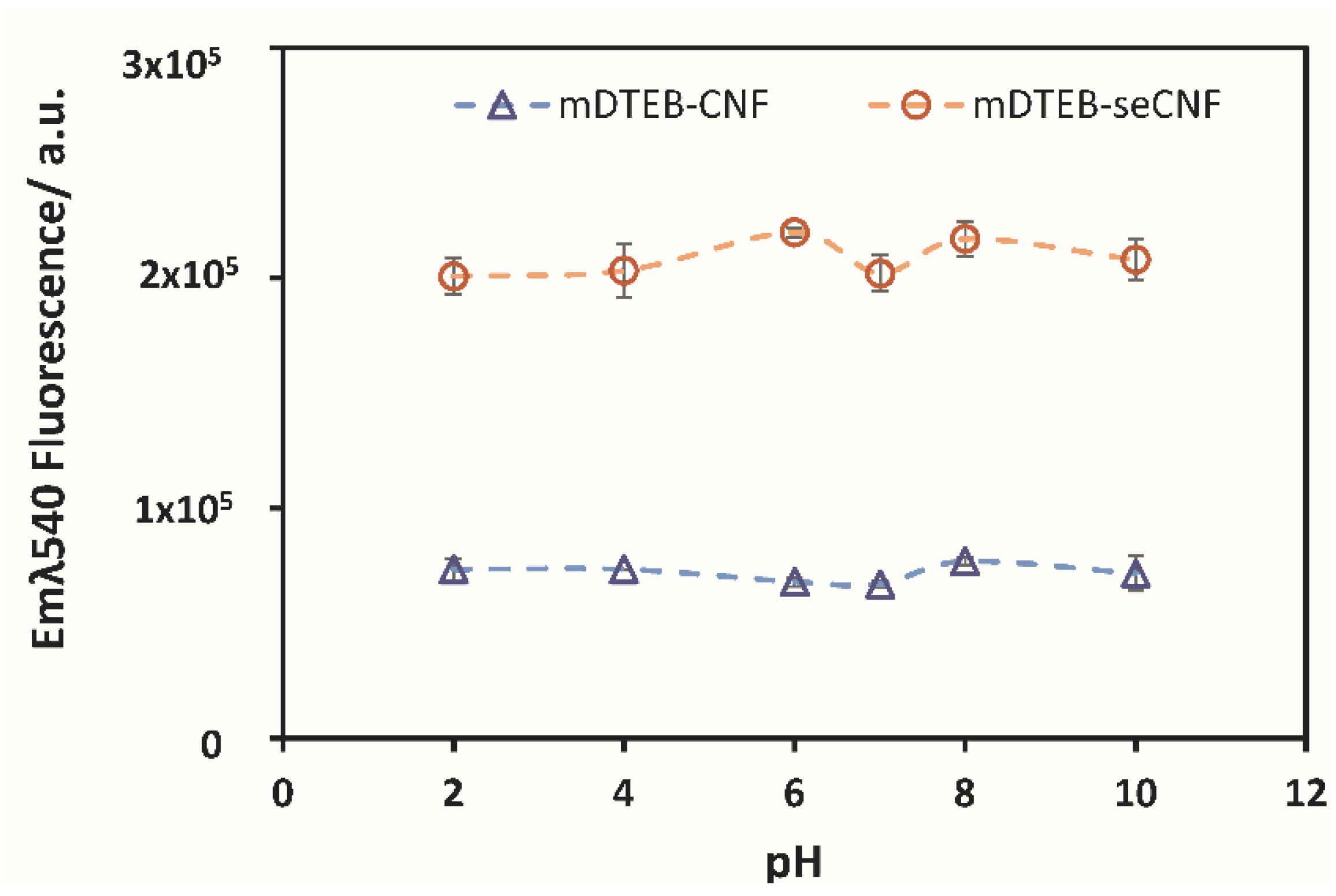
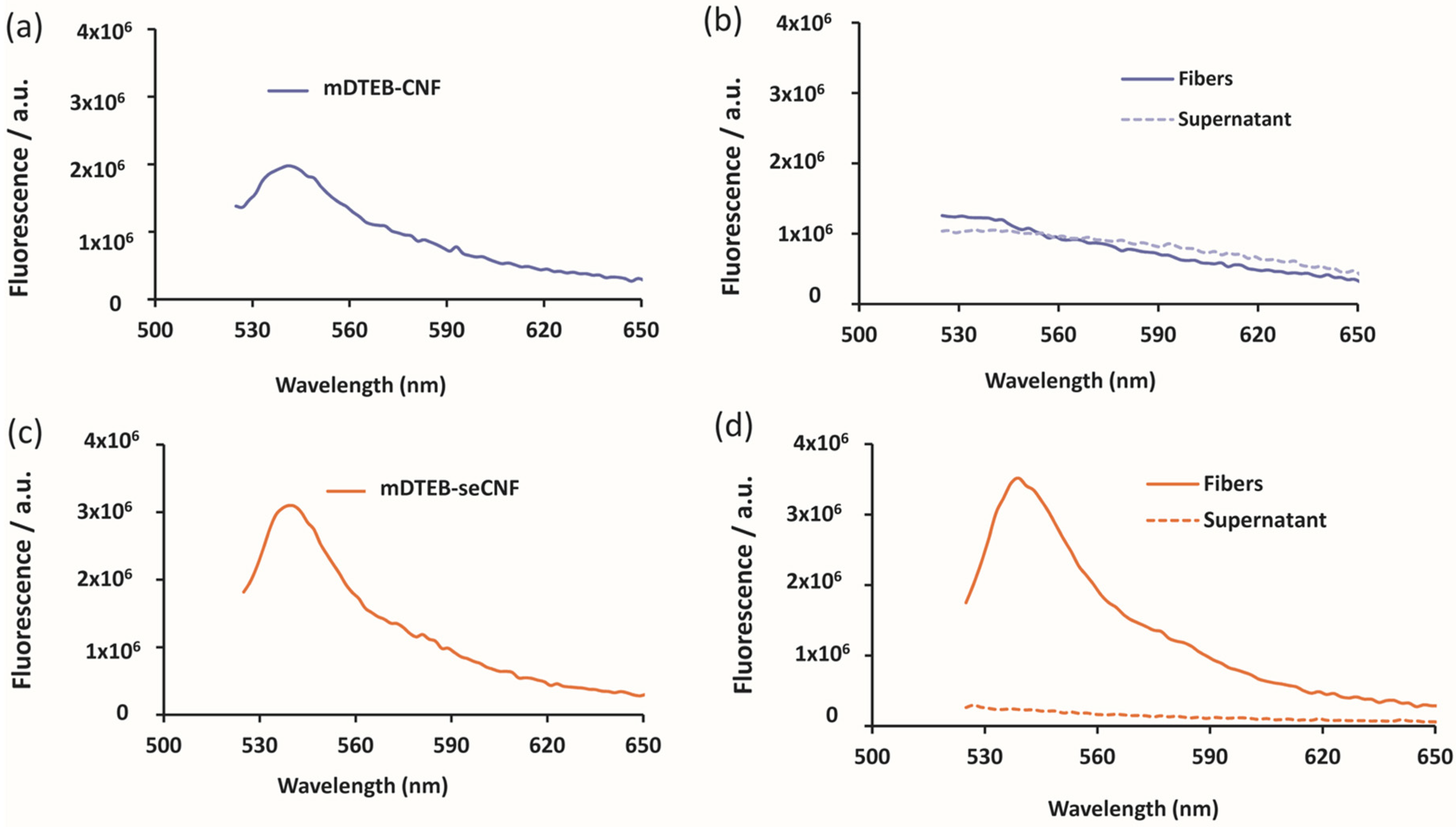

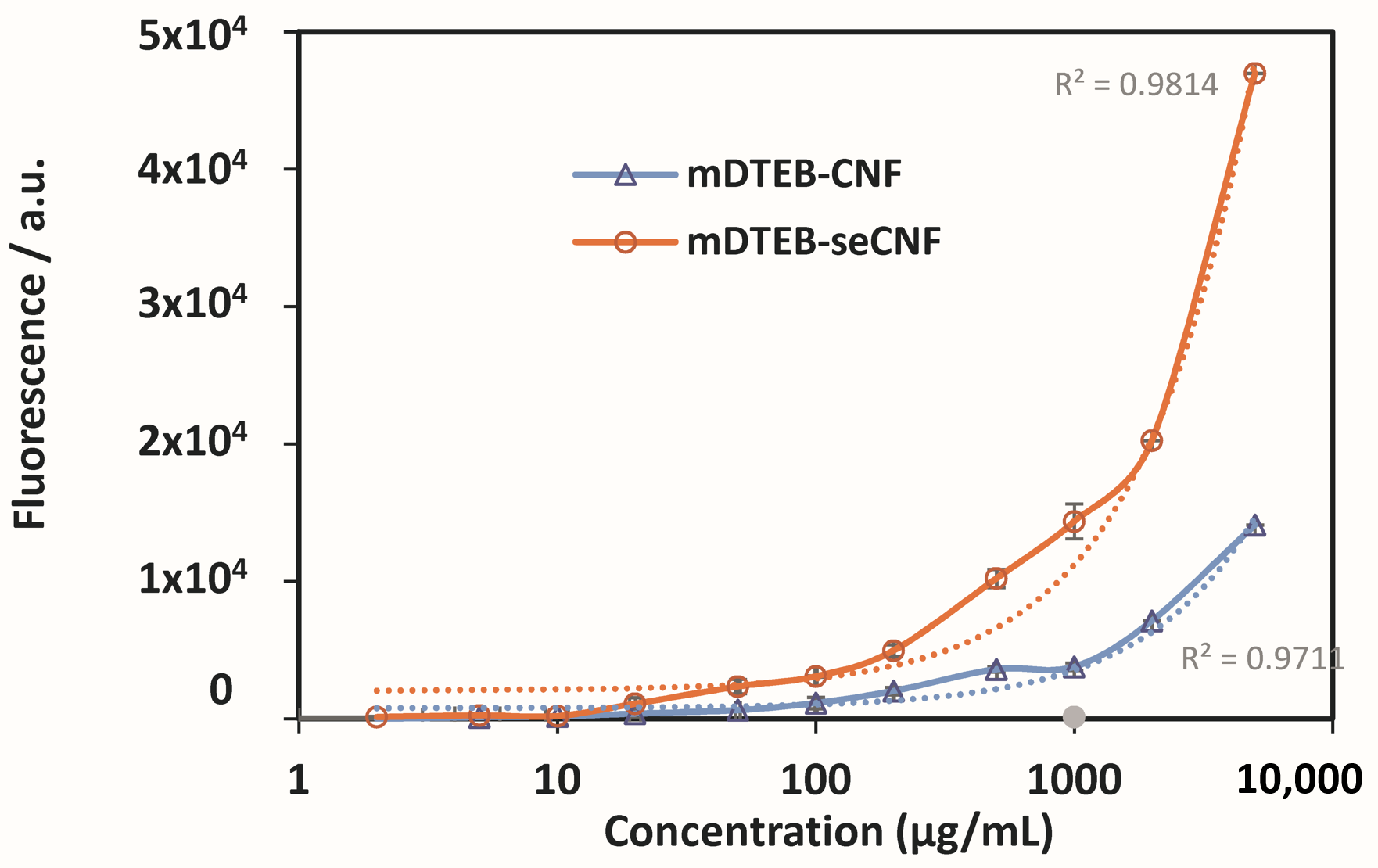
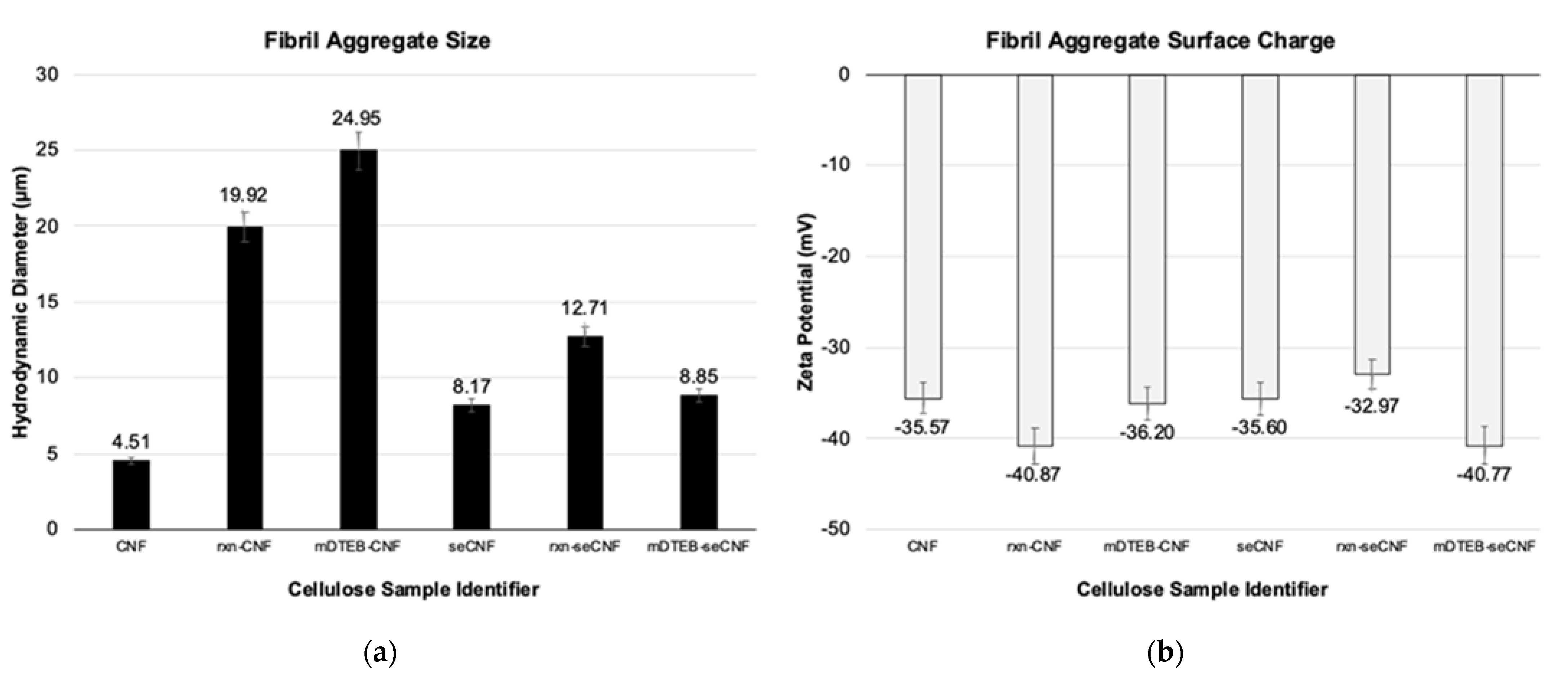
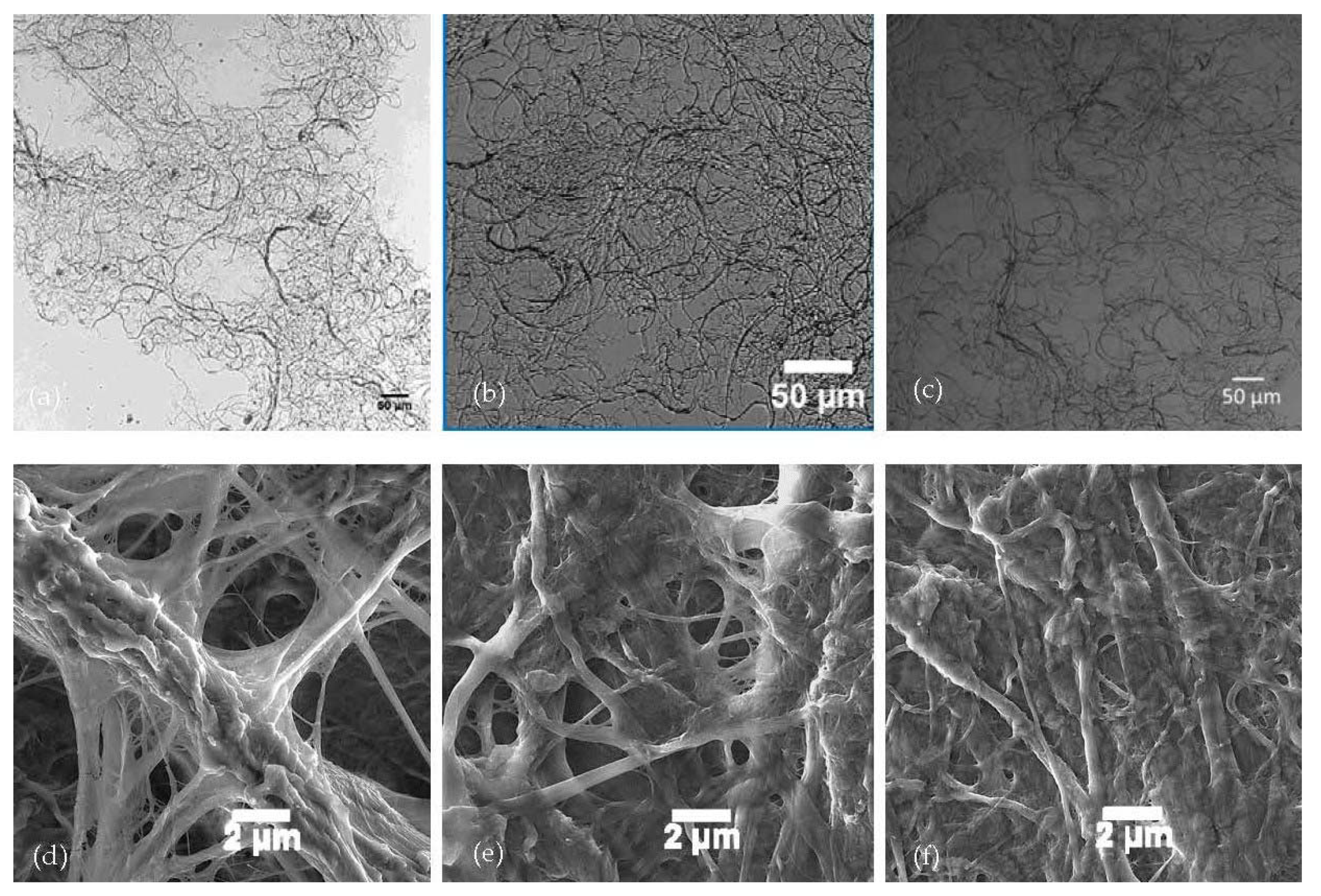
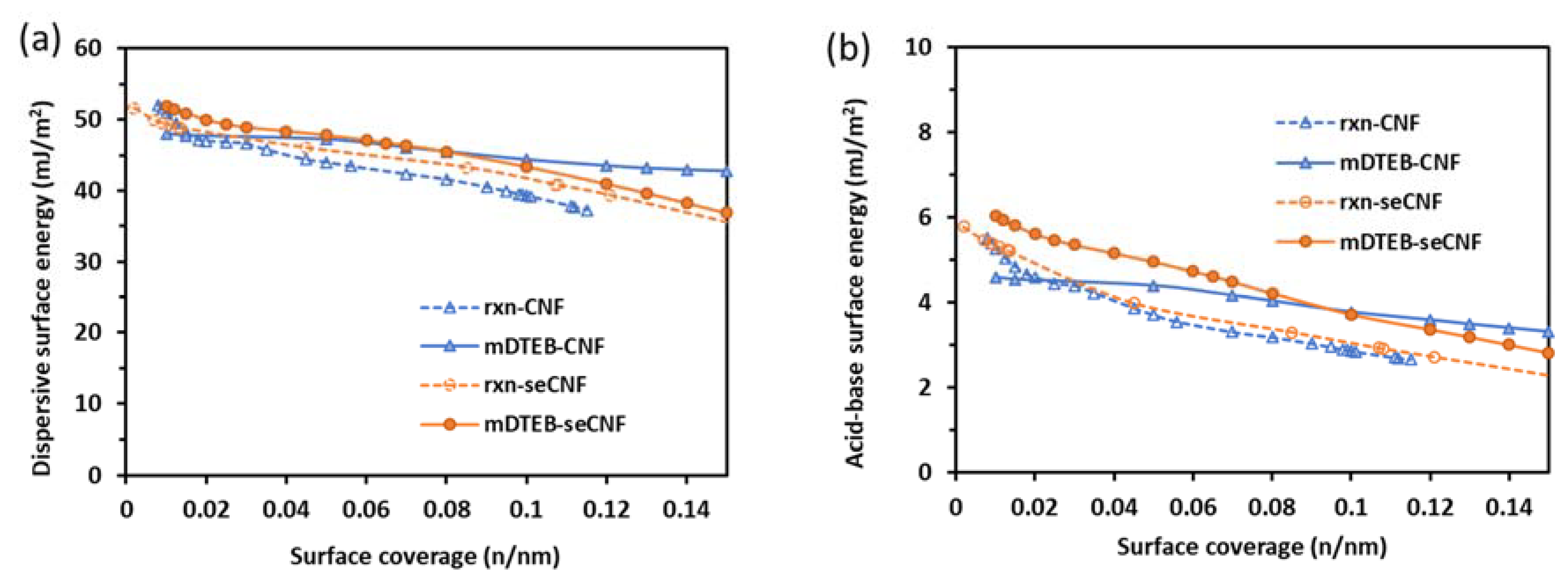
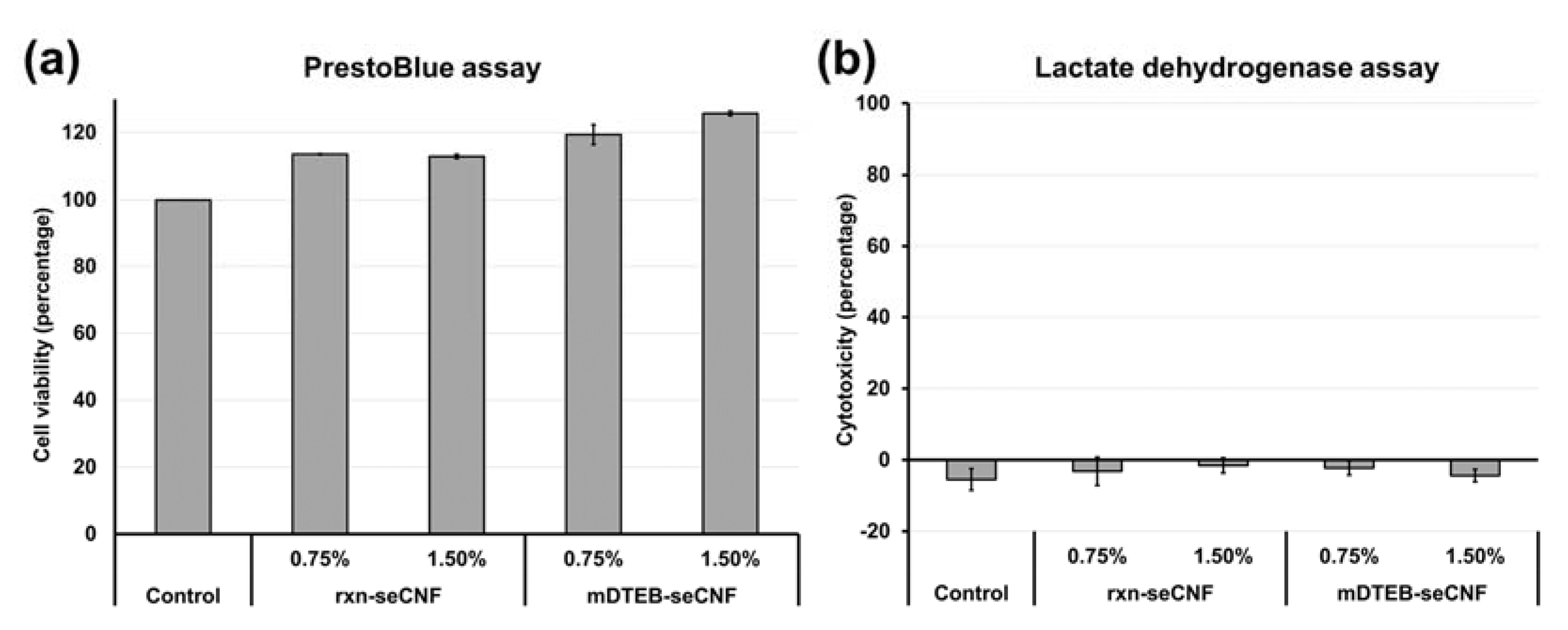
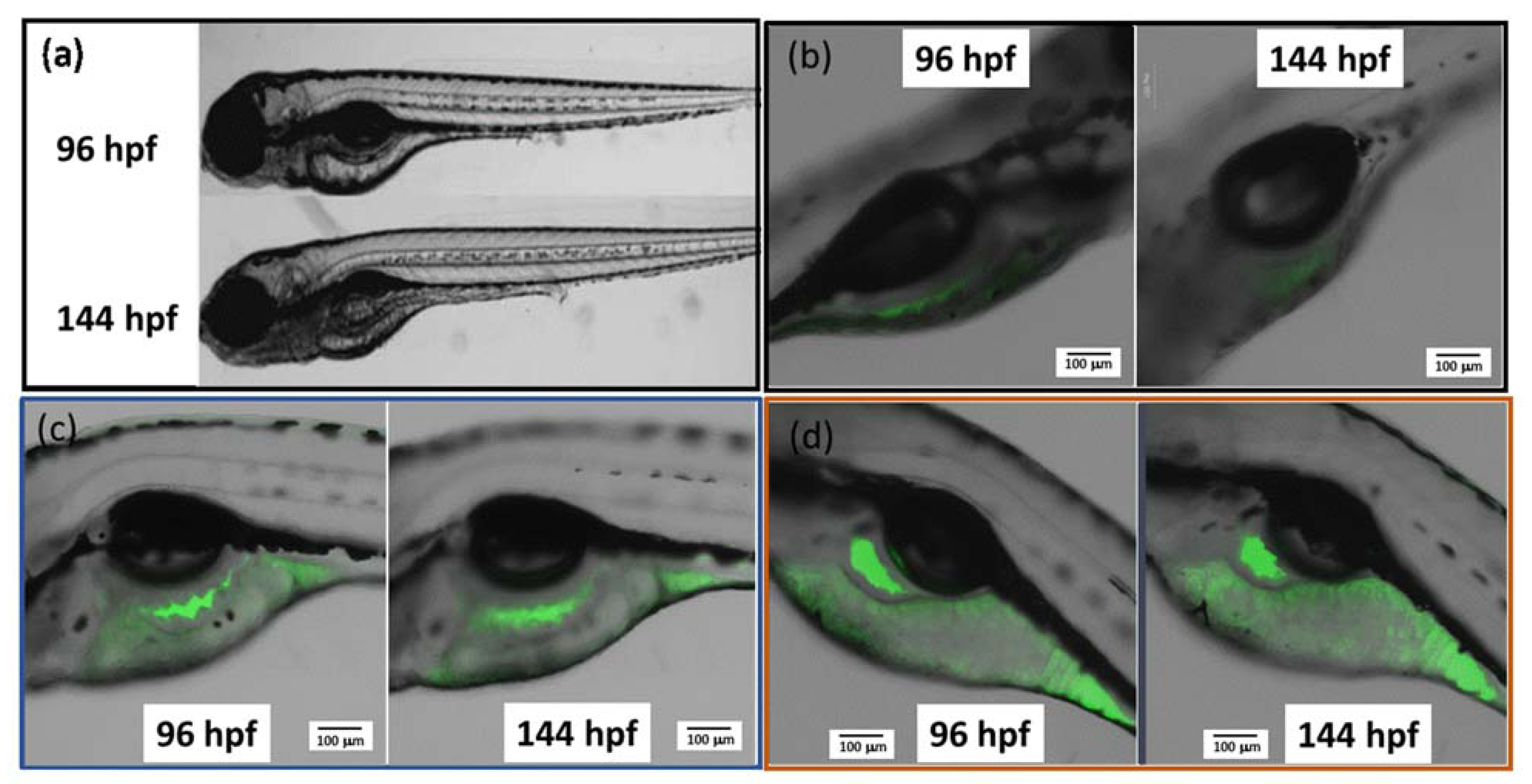
| Abbreviation | Material Description |
|---|---|
| mDTEB | Synthesized fluorophore, meso-DichloroTriazineEthyl BODIPY |
| CNF | Cellulose nanofibrils, as received |
| seCNF | Surface extracted CNF |
| mDTEB-CNF | mDTEB labeled as received CNF |
| mDTEB-seCNF | mDTEB labeled surface extracted CNF |
| rxn-CNF | As received CNF exposed to reaction conditions without presence of mDTEB |
| rxn-seCNF | Surface extracted CNF exposed to reaction conditions without presence of mDTEB |
Publisher’s Note: MDPI stays neutral with regard to jurisdictional claims in published maps and institutional affiliations. |
© 2021 by the authors. Licensee MDPI, Basel, Switzerland. This article is an open access article distributed under the terms and conditions of the Creative Commons Attribution (CC BY) license (https://creativecommons.org/licenses/by/4.0/).
Share and Cite
Patel, I.; Woodcock, J.; Beams, R.; Stranick, S.J.; Nieuwendaal, R.; Gilman, J.W.; Mulenos, M.R.; Sayes, C.M.; Salari, M.; DeLoid, G.; et al. Fluorescently Labeled Cellulose Nanofibers for Environmental Health and Safety Studies. Nanomaterials 2021, 11, 1015. https://doi.org/10.3390/nano11041015
Patel I, Woodcock J, Beams R, Stranick SJ, Nieuwendaal R, Gilman JW, Mulenos MR, Sayes CM, Salari M, DeLoid G, et al. Fluorescently Labeled Cellulose Nanofibers for Environmental Health and Safety Studies. Nanomaterials. 2021; 11(4):1015. https://doi.org/10.3390/nano11041015
Chicago/Turabian StylePatel, Ilabahen, Jeremiah Woodcock, Ryan Beams, Stephan J. Stranick, Ryan Nieuwendaal, Jeffrey W. Gilman, Marina R. Mulenos, Christie M. Sayes, Maryam Salari, Glen DeLoid, and et al. 2021. "Fluorescently Labeled Cellulose Nanofibers for Environmental Health and Safety Studies" Nanomaterials 11, no. 4: 1015. https://doi.org/10.3390/nano11041015
APA StylePatel, I., Woodcock, J., Beams, R., Stranick, S. J., Nieuwendaal, R., Gilman, J. W., Mulenos, M. R., Sayes, C. M., Salari, M., DeLoid, G., Demokritou, P., Harper, B., Harper, S., Ong, K. J., Shatkin, J. A., & Fox, D. M. (2021). Fluorescently Labeled Cellulose Nanofibers for Environmental Health and Safety Studies. Nanomaterials, 11(4), 1015. https://doi.org/10.3390/nano11041015








